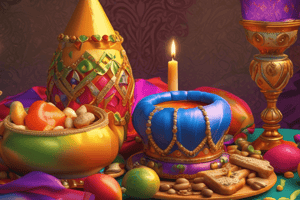Podcast
Questions and Answers
Who is the central figure in the Purim story?
Who is the central figure in the Purim story?
Esther
What event led to the search for a new queen in the Persian Empire?
What event led to the search for a new queen in the Persian Empire?
The execution of Queen Vashti
What was Esther's response when she became queen?
What was Esther's response when she became queen?
She found it hard because she didn't want to be queen and refused to disclose her nationality
Who was the antagonist in the Purim story?
Who was the antagonist in the Purim story?
What was Achashverosh's role in the Purim story?
What was Achashverosh's role in the Purim story?
What was the diabolical scheme planned by Haman?
What was the diabolical scheme planned by Haman?
Why is the holiday called Purim?
Why is the holiday called Purim?
How does Purim differ from other Jewish holidays like Passover?
How does Purim differ from other Jewish holidays like Passover?
What are some similarities between the Purim story and events in Jewish communities throughout history?
What are some similarities between the Purim story and events in Jewish communities throughout history?
When and why did Esther reveal her Jewish identity to the king?
When and why did Esther reveal her Jewish identity to the king?
What are the four Purim mitzvahs or observances?
What are the four Purim mitzvahs or observances?
What is a common Purim tradition?
What is a common Purim tradition?
What are hamantaschen and what do they represent?
What are hamantaschen and what do they represent?
When do Jews in walled cities celebrate Purim?
When do Jews in walled cities celebrate Purim?
What happens in Jewish leap years with two Adar months?
What happens in Jewish leap years with two Adar months?
What is the significance of 14 Adar I in leap years?
What is the significance of 14 Adar I in leap years?
Flashcards
What is Purim?
What is Purim?
A Jewish holiday commemorating the salvation of the Jewish people from Haman's plot in ancient Persia.
When is Purim celebrated?
When is Purim celebrated?
The holiday is celebrated on the 14th of Adar, but on the 15th in walled cities like Jerusalem.
Who was Haman?
Who was Haman?
Haman, the prime minister, plotted to exterminate all the jews, but Esther revealed her Jewish identity to the king.
Who was Queen Esther?
Who was Queen Esther?
Signup and view all the flashcards
Who was Mordechai?
Who was Mordechai?
Signup and view all the flashcards
What are the 4 Purim observances?
What are the 4 Purim observances?
Signup and view all the flashcards
What is the Megillah?
What is the Megillah?
Signup and view all the flashcards
What is "Giving to the Poor"?
What is "Giving to the Poor"?
Signup and view all the flashcards
What is Hamantaschen?
What is Hamantaschen?
Signup and view all the flashcards
Why is there fasting?
Why is there fasting?
Signup and view all the flashcards
What does "Purim" mean?
What does "Purim" mean?
Signup and view all the flashcards
What is the meaning of Purim?
What is the meaning of Purim?
Signup and view all the flashcards
Mishloach Manot and Matanot L'evyonim
Mishloach Manot and Matanot L'evyonim
Signup and view all the flashcards
What is dressing up on Purim?
What is dressing up on Purim?
Signup and view all the flashcards
What does Purim celebrate?
What does Purim celebrate?
Signup and view all the flashcards
Study Notes
Purim 101
- Purim is a Jewish holiday celebrated every year on the 14th of the Hebrew month of Adar, typically in late winter or early spring.
- Purim 2024 begins on Saturday night, March 23, and continues through Sunday, March 24, extending to Monday in Jerusalem.
- The holiday commemorates the salvation of the Jewish people from Haman's plot to destroy them in the ancient Persian empire.
The Story of Purim
- The Persian Empire, which extended over 127 lands, had all the Jews as its subjects in the 4th century BCE.
- King Ahasuerus executed his wife, Queen Vashti, and arranged a beauty pageant to find a new queen, which Esther, a Jewish girl, won.
- Esther became queen, but refused to divulge her nationality, while Mordechai, her cousin, defied the king's orders and refused to bow to Haman, the Jew-hating prime minister.
- Haman convinced the king to issue a decree ordering the extermination of all Jews on the 13th of Adar, a date chosen by a lottery.
- Mordechai galvanized the Jews to repent, fast, and pray to G‑d, while Esther revealed her Jewish identity to the king, leading to Haman's hanging and Mordechai's appointment as prime minister.
- The Jews mobilized and killed their enemies on the 13th of Adar, rested on the 14th, and celebrated.
Naming and Observances
- Purim means "lots" in ancient Persian, named after Haman's lottery to determine the date of his diabolical scheme.
- Purim observances include:
- Reading the Megillah (book of Esther) on the eve and day of Purim.
- Giving money gifts to at least two poor people.
- Sending gifts of two kinds of food to at least one person.
- A festive Purim feast, often including wine or other intoxicating beverages.
Traditions and Customs
- Purim is characterized by a spirit of liveliness and fun.
- It is customary for children (and adults) to dress up in costumes.
- Traditional Purim food is hamantaschen (three-cornered pastries with poppy seeds or sweet filling).
- Many Jews fast on the day before Purim (or on the Thursday before, when Purim is on Sunday) to commemorate Esther's fasting and praying.
When to Celebrate
- Common Custom: Jews celebrate Purim on Adar 14, the day when their ancestors rested from the war against their enemies.
- Walled Cities: In cities that were surrounded by walls in the days of Joshua, such as Jerusalem, Purim is celebrated on the 15th.
- Small Towns: In ancient times, villagers read the Megillah on the market day preceding 14 Adar, but this custom is no longer practiced.
- Note: On Jewish leap years, there are two months called Adar, and Purim is celebrated in the second Adar.
The Meaning of Purim
- Purim expresses the idea that G‑d is intimately involved in every aspect of the world, even when there are no overt miracles.
- The holiday celebrates G‑d's salvation of the Jews, despite Haman's efforts, and the spiritual revival that occurred among the Jews as a result.
Studying That Suits You
Use AI to generate personalized quizzes and flashcards to suit your learning preferences.




